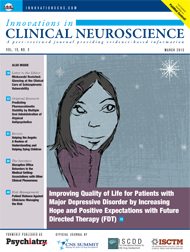Welcome to the March 2013 issue of Innovations in Clinical Neuroscience. We start this issue with a study by Vilhauer et al titled, “Improving Quality of Life for Patients with Major Depressive Disorder by Increasing Hope and Positive Expectations with Future Directed Therapy (FDT).” Here the authors examined a new therapy, FDT, for the treatment for depression that focuses on reducing hopelessness and increasing positive future anticipation, which are factors posited to contribute to quality of life. The new treatment was compared to depressed patients in the same setting treated with group cognitive behavioral therapy. The authors found that patients treated with FDT demonstrated significant improvements in quality of life, while those treated in the cognitive behavioral therapy group did not.
For those with an interest in pharmacology, we next present a study by Wakamatsu et al titled, “Predicting Pharmacokinetic Stability by Multiple Oral Administration of Atypical Antipsychotics.” According to the authors, reduction of peak concentration of antipsychotic medication in patients with schizophrenia can decrease the risk of dose-dependent side effects, while an increase in trough concentration of the medication can decrease the incidence of lack of efficacy due to subtherapeutic drug concentration. In their study, the authors calculated the fluctuation index of peak-to-trough plasma-concentration of several first-line second generation antipsychotic medications. The authors found that aripiprazole followed by paliperidone extended release had the lowest fluctuation indices, while perospirone followed by quetiapine had the greatest fluctuation.
Next, as all clinicians know, effectively managing the treatment of a dying child poses many ethical and psychological challenges for the healthcare professionals. In their review article titled, “Helping the Angels: A Review of Understanding and Helping Dying Children,” Sarwar, Mangewala, and Baron discuss some of these ethical and psychological challenges, including disclosure of the diagnosis and grief counseling to the child and family, and offer strategies on effectively handling these difficult matters.
Aggression and violence in the medical setting is a serious potential occurrence for which all healthcare professionals, including psychiatrists, should be well prepared. We wrap up the issue covering this topic through two of our regular columns this month. In this month’s “The Interface,” Sansone and Sansone examine aggressive and disruptive office behaviors from the perspective of the perpetrators—the patients. The authors found through a series of studies that disruptive office behaviors by patients appear to be related to borderline personality symptomatology, alcohol/drug misuse, prescription medication abuse, and higher rates of past mental healthcare utilization. This information suggests a rudimentary psychological profile clinicians can use in their practice for identifying and effectively managing potentially aggressive patients in the primary care setting. Then, in this month’s “Risk Management” column, Taylor discusses strategies, from a legal perspective, for managing the risk of patient violence against clinicians.
We hope you enjoy the issue. As always, we welcome your submissions and feedback.
Sincerely,
Amir Kalali, MD
Editor, Innovations in Clinical Neuroscience






